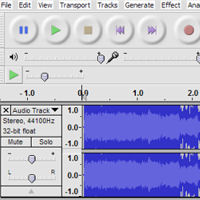Using Audacity® as Visual Feedback With a Nine Year Old Boy
 |
About the presenter: Judy Butler is an ASHA Board Recognized Specialist in Fluency Disorders in private practice. She has 26 years experience as a clinician. Her caseload is primarily children who receive minimal or no fluency therapy due to restrictive public school regulations. Visit http://sites.google.com/site/slpnotesonstuttering/ to access her original therapy ideas as well as helpful links. Contact her at slpconversation@gmail.com if you would like an invitation to her private blog at http://butlerspeechtherapy.blogspot.com. |
Using Audacity® as Visual Feedback with a Nine Year Old Boy
by Judith V. Butler
from Massachusetts, USA
This paper describes how a FREE download from Audacity® was helpful in the case of a nine-year old boy, whom I will refer to as Marcus (not his real name). "The Audacity® is free, open source software for recording and editing sounds. It is available for Mac OS X, Microsoft Windows, GNU/Linux, and other operating systems." (1) Using the speech wave form generated by Audacity®, Marcus practiced fluency enhancing techniques (2) to produce a more fluent speech pattern. We tried Audacity⪚ because it was my clinical impression that principals of motor learning and sensory processing (3, 4) were relevant to his progress.
 The beauty of Audacity® lay in its quick, user-friendly format. I was not technically savvy and did not need expensive, highly sensitive equipment. I just wanted to supplement Marcus' motor and auditory processing (5) with something visual. After downloading Audacity® to a laptop computer, I plugged in a microphone and we were 'good to go.' With the push of an on-screen 'button,' we recorded single words, phrases, and short sentences. I role-modeled activities and then Marcus eagerly tried them himself. His family downloaded Audacity® for homework.
The beauty of Audacity® lay in its quick, user-friendly format. I was not technically savvy and did not need expensive, highly sensitive equipment. I just wanted to supplement Marcus' motor and auditory processing (5) with something visual. After downloading Audacity® to a laptop computer, I plugged in a microphone and we were 'good to go.' With the push of an on-screen 'button,' we recorded single words, phrases, and short sentences. I role-modeled activities and then Marcus eagerly tried them himself. His family downloaded Audacity® for homework.
Audacity® allowed Marcus to see his speech appear as a wave form in real time. He discovered the gentle slopes of easy onsets, the short bursts of sound repetitions, the abrupt beginnings of blocks, and the varying lengths of pauses as he resisted time pressure. Marcus became a scientist, experimenting with fluency shaping, voluntary stuttering, and stuttering modifications to see what they looked like. Soon he was isolating segments of speech to play back and hear if they were environmental noise, breathing, disfluency, "speech tools," or speech sounds. Marcus saw the product of his oral-motor performance (6) and had fun doing it. His fluency improved as he applied speech changes more consistently with the assistance of this visual aid.
My most recent therapeutic journeys (7) have prompted me to rethink stuttering in terms of sensory processing. (8) Marcus excelled in school, loved to "build things," and bubbled over with the enthusiasm of a gifted & talented child. (9) Why was it so difficult for him to use his "new speech" skills for more than a few sentences? As it turned out, Marcus could modify his speech more consistently with the addition of the Audacity® visual feedback. Perhaps appreciating Marcus' strong visual learning style was essential to his progress.
I understand that stuttering requires a multidimensional therapy approach and we are not chasing perfection. Marcus can shift in and out of his more fluent speech as if it were a second language. We value him as a child who stutters. However, in my opinion, in this particular case, I'm wondering if continued progress with his more fluent speech will require appropriate sensory feedback so that he can self-monitor accurately. I'm looking forward to a future with additional user-friendly, open source technology. I gratefully accept advice about what is already available.
Bibliography
- http://www.audacity.sourceforge.net
- Healey, E.C. & Scott, L. A. (1995). Strategies for Treating Elementary School-Age Children Who Stutter: An Integrative Approach. Language, Speech, and Hearing Services in Schools, 26, 151-161.
- Mass, E., Robin, D.A., Austermann Hula, S., Freedman, S.E., Wulf, G., Ballard, K.J., Schmidt, R.A. (2008). Principals of Motor Learning in Treatment of Motor Speech Disorders. American Journal of Speech-Language Pathology, 17, 277-298.
- Cheng, H.Y, Murdoch, B.E., Gooz'e, Scott, D. (2007). Physiologic Development of Tongue-jaw Coordination From Childhood to Adult. Journal of Speech, Language, and Hearing Research. 50, 352-360.
- Nittrouer, S. (2002). From Ear to Cortex: A Perspective on What Clinicians Need to Understand About Speech Perception and Language Processing. Language, Speech, and Hearing Services in Schools, 33, 237-252.
- Freedman, S.E., Maas, E., Caligiuri, M.P., Wulf, G., Robin, D.A. (2007). Internal Versus External: Oral Motor Performance as a Function of Attentional Focus. Journal of Speech, Language, and Hearing Research, 50, 131-136.
- Pelczarski, K. M. & Yaruss, J.S. (2008) Accompanying a Client on His Therapy Journey. Perspectives on Fluency and Fluency Disorders, 18, 64-68.
- Six Blind Men and the Elephant: a Pop-Up Storybook (1990). Long Beach, CA: Compass Productions.
- www.nagc.org .
August 2, 2009

